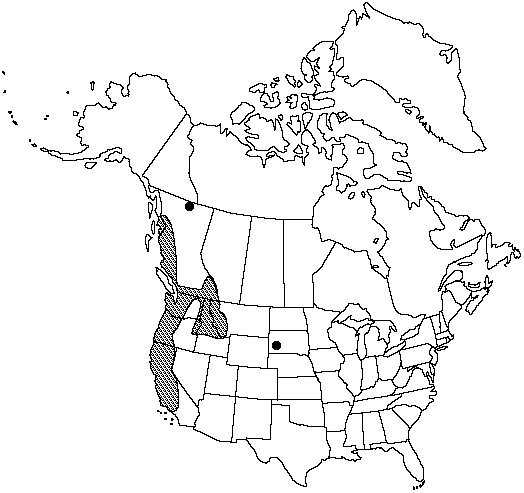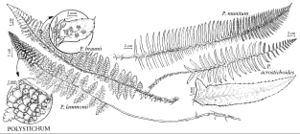Difference between revisions of "Polystichum munitum"
Tent. Pterid. 83. 1836.
FNA>Volume Importer |
imported>Volume Importer |
||
| (7 intermediate revisions by 2 users not shown) | |||
| Line 8: | Line 8: | ||
}} | }} | ||
|common_names=Common sword fern | |common_names=Common sword fern | ||
| − | |basionyms={{Treatment/ID/ | + | |special_status={{Treatment/ID/Special_status |
| + | |code=F | ||
| + | |label=Illustrated | ||
| + | }} | ||
| + | |basionyms={{Treatment/ID/Basionym | ||
|name=Aspidium munitum | |name=Aspidium munitum | ||
|authority=Kaulfuss | |authority=Kaulfuss | ||
| + | |rank=species | ||
| + | |publication_title=Enum. Filic., | ||
| + | |publication_place=236. 1824 | ||
}} | }} | ||
|synonyms= | |synonyms= | ||
| Line 20: | Line 27: | ||
}}<!-- | }}<!-- | ||
| − | --><span class="statement" id="st- | + | --><span class="statement" id="st-undefined" data-properties=""><b>Stems </b>erect or ascending. <b>Leaves</b> arching, 5–18 dm; bulblets absent. <b>Petiole</b> 1/8–1/4 length of leaf, densely scaly; scales red-brown to dark brown or nearly black, gradually diminishing in size distally. <b>Blade</b> linear-lanceolate, 1-pinnate, base slightly narrowed. <b>Pinnae</b> narrowly lanceolate, straight to falcate, not overlapping, pinnae of shade-growing plants in 1 plane, those of sun-growing plants twisted or contorted, 1–15 cm; base ± cuneate, auricles well developed; margins serrulate-spiny with teeth ascending; apex acuminate with subapical teeth same size as apical tooth; microscales ovate-lanceolate to linear-lanceolate, with contorted projections, dense, on abaxial surface only. <b>Indusia</b> ciliate. <b>Spores</b> light yellow. <b>2n</b> = 82.</span><!-- |
-->{{Treatment/Body | -->{{Treatment/Body | ||
| Line 26: | Line 33: | ||
|elevation=0–2200 m | |elevation=0–2200 m | ||
|distribution=B.C.;Calif.;Idaho;Mont.;Oreg.;S.Dak.;Wash.;Mexico on Guadalupe Island;naturalized in Europe. | |distribution=B.C.;Calif.;Idaho;Mont.;Oreg.;S.Dak.;Wash.;Mexico on Guadalupe Island;naturalized in Europe. | ||
| − | |discussion=<p>One of the most abundant ferns in the western flora (rivaled only by Pteridium), Polystichum munitum also is of significant economic importance. Enormous quantities of leaves are gathered for backgrounds in funeral wreaths and other floral displays; the evergreen leaves keep well in cold storage and are exported to Europe. It is extensively used in landscaping, the trade being mainly in wild-collected plants.</p><!-- | + | |discussion=<p>One of the most abundant ferns in the western flora (rivaled only by <i>Pteridium</i>), <i>Polystichum munitum</i> also is of significant economic importance. Enormous quantities of leaves are gathered for backgrounds in funeral wreaths and other floral displays; the evergreen leaves keep well in cold storage and are exported to Europe. It is extensively used in landscaping, the trade being mainly in wild-collected plants.</p><!-- |
| − | --><p>Polystichum munitum appears to be most closely related to P. imbricans based on morphologic (D. H. Wagner 1979) and electrophoretic (P. S. Soltis et al. 1990) analyses. The chloroplast DNA of P. imbricans, however, is divergent (G. Yatskievych et al. 1988), suggesting a chloroplast origin independent of the nuclear genome. That Polystichum munitum is related to P. acrostichoides is supported by data from chloroplast DNA analysis (G. Yatskievych et al. 1988) but contradicted by data from electrophoretic studies (P. S. Soltis et al. 1990).</p><!-- | + | --><p><i>Polystichum munitum</i> appears to be most closely related to <i>P. imbricans</i> based on morphologic (D. H. Wagner 1979) and electrophoretic (P. S. Soltis et al. 1990) analyses. The chloroplast DNA of <i>P. imbricans</i>, however, is divergent (G. Yatskievych et al. 1988), suggesting a chloroplast origin independent of the nuclear genome. That <i>Polystichum munitum</i> is related to <i>P. acrostichoides</i> is supported by data from chloroplast DNA analysis (G. Yatskievych et al. 1988) but contradicted by data from electrophoretic studies (P. S. Soltis et al. 1990).</p><!-- |
| − | --><p>Polystichum munitum can be distinguished from P. imbricans by its persistent, wide (the largest wider than 1 mm) distal petiolar scales; such scales of P. imbricans are less than 1 mm wide and fall off early.</p><!-- | + | --><p><i>Polystichum munitum</i> can be distinguished from <i>P. imbricans</i> by its persistent, wide (the largest wider than 1 mm) distal petiolar scales; such scales of <i>P. imbricans</i> are less than 1 mm wide and fall off early.</p><!-- |
| − | --><p>From an evolutionary standpoint, Polystichum munitum is a diploid progenitor of P. andersonii, P. californicum, P. setigerum, and, perhaps, P. scopulinum. Hybrids with all except P. setigerum have been reported, all triploid, attesting to its parental role in the tetraploids (see discussion under each). Hybrids with P. braunii (A. Sleep and T. Reichstein 1967), P. kruckebergii (P. S. Soltis et al. 1987), P. dudleyi (W. H. Wagner Jr. 1973), and P. lemmonii (P. S. Soltis et al. 1989) also have been reported.</p><!-- | + | --><p>From an evolutionary standpoint, <i>Polystichum munitum</i> is a diploid progenitor of <i>P. andersonii</i>, <i>P. californicum</i>, <i>P. setigerum</i>, and, perhaps, <i>P. scopulinum</i>. Hybrids with all except <i>P. setigerum</i> have been reported, all triploid, attesting to its parental role in the tetraploids (see discussion under each). Hybrids with <i>P. braunii</i> (A. Sleep and T. Reichstein 1967), <i>P. kruckebergii</i> (P. S. Soltis et al. 1987), <i>P. dudleyi</i> (W. H. Wagner Jr. 1973), and <i>P. lemmonii</i> (P. S. Soltis et al. 1989) also have been reported.</p><!-- |
| − | --><p>The population on Guadalupe Island has been called Polystichum solitarium Maxon.</p> | + | --><p>The population on Guadalupe Island has been called <i>Polystichum</i> solitarium Maxon.</p> |
|tables= | |tables= | ||
|references= | |references= | ||
| Line 39: | Line 46: | ||
-->{{#Taxon: | -->{{#Taxon: | ||
name=Polystichum munitum | name=Polystichum munitum | ||
| − | |||
|authority=(Kaulfuss) C. Presl | |authority=(Kaulfuss) C. Presl | ||
|rank=species | |rank=species | ||
| Line 52: | Line 58: | ||
|publication title=Tent. Pterid. | |publication title=Tent. Pterid. | ||
|publication year=1836 | |publication year=1836 | ||
| − | |special status= | + | |special status=Illustrated |
| − | |source xml=https:// | + | |source xml=https://bitbucket.org/aafc-mbb/fna-data-curation/src/2e0870ddd59836b60bcf96646a41e87ea5a5943a/coarse_grained_fna_xml/V2/V2_179.xml |
|genus=Polystichum | |genus=Polystichum | ||
|species=Polystichum munitum | |species=Polystichum munitum | ||
| − | |||
| − | |||
| − | |||
| − | |||
| − | |||
| − | |||
| − | |||
| − | |||
| − | |||
| − | |||
| − | |||
| − | |||
| − | |||
| − | |||
| − | |||
| − | |||
| − | |||
| − | |||
| − | |||
| − | |||
| − | |||
| − | |||
| − | |||
| − | |||
| − | |||
| − | |||
| − | |||
| − | |||
}}<!-- | }}<!-- | ||
-->[[Category:Treatment]][[Category:Polystichum]] | -->[[Category:Treatment]][[Category:Polystichum]] | ||
Latest revision as of 21:21, 5 November 2020
Stems erect or ascending. Leaves arching, 5–18 dm; bulblets absent. Petiole 1/8–1/4 length of leaf, densely scaly; scales red-brown to dark brown or nearly black, gradually diminishing in size distally. Blade linear-lanceolate, 1-pinnate, base slightly narrowed. Pinnae narrowly lanceolate, straight to falcate, not overlapping, pinnae of shade-growing plants in 1 plane, those of sun-growing plants twisted or contorted, 1–15 cm; base ± cuneate, auricles well developed; margins serrulate-spiny with teeth ascending; apex acuminate with subapical teeth same size as apical tooth; microscales ovate-lanceolate to linear-lanceolate, with contorted projections, dense, on abaxial surface only. Indusia ciliate. Spores light yellow. 2n = 82.
Habitat: Terrestrial, forest floor, only occasionally on rock, in mesic coniferous to moist, mixed evergreen forests
Elevation: 0–2200 m
Distribution

B.C., Calif., Idaho, Mont., Oreg., S.Dak., Wash., Mexico on Guadalupe Island, naturalized in Europe.
Discussion
One of the most abundant ferns in the western flora (rivaled only by Pteridium), Polystichum munitum also is of significant economic importance. Enormous quantities of leaves are gathered for backgrounds in funeral wreaths and other floral displays; the evergreen leaves keep well in cold storage and are exported to Europe. It is extensively used in landscaping, the trade being mainly in wild-collected plants.
Polystichum munitum appears to be most closely related to P. imbricans based on morphologic (D. H. Wagner 1979) and electrophoretic (P. S. Soltis et al. 1990) analyses. The chloroplast DNA of P. imbricans, however, is divergent (G. Yatskievych et al. 1988), suggesting a chloroplast origin independent of the nuclear genome. That Polystichum munitum is related to P. acrostichoides is supported by data from chloroplast DNA analysis (G. Yatskievych et al. 1988) but contradicted by data from electrophoretic studies (P. S. Soltis et al. 1990).
Polystichum munitum can be distinguished from P. imbricans by its persistent, wide (the largest wider than 1 mm) distal petiolar scales; such scales of P. imbricans are less than 1 mm wide and fall off early.
From an evolutionary standpoint, Polystichum munitum is a diploid progenitor of P. andersonii, P. californicum, P. setigerum, and, perhaps, P. scopulinum. Hybrids with all except P. setigerum have been reported, all triploid, attesting to its parental role in the tetraploids (see discussion under each). Hybrids with P. braunii (A. Sleep and T. Reichstein 1967), P. kruckebergii (P. S. Soltis et al. 1987), P. dudleyi (W. H. Wagner Jr. 1973), and P. lemmonii (P. S. Soltis et al. 1989) also have been reported.
The population on Guadalupe Island has been called Polystichum solitarium Maxon.
Selected References
None.
